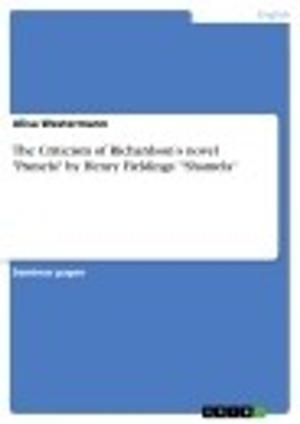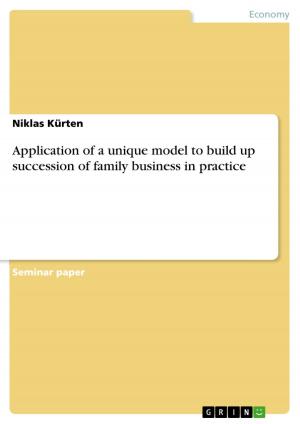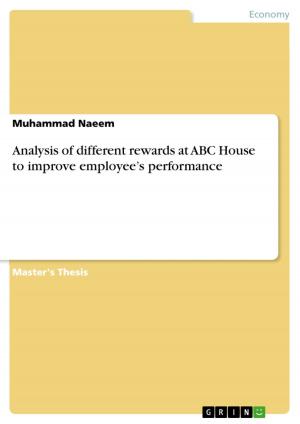The Australian airline industry and the case of OzJet
A strategic analysis report
Business & Finance, Management & Leadership, Management| Author: | Marco Hierling | ISBN: | 9783638805612 |
| Publisher: | GRIN Publishing | Publication: | June 22, 2007 |
| Imprint: | GRIN Publishing | Language: | English |
| Author: | Marco Hierling |
| ISBN: | 9783638805612 |
| Publisher: | GRIN Publishing |
| Publication: | June 22, 2007 |
| Imprint: | GRIN Publishing |
| Language: | English |
Seminar paper from the year 2007 in the subject Business economics - Business Management, Corporate Governance, grade: 1,3 (86%), The University of Sydney, 45 entries in the bibliography, language: English, abstract: This case study provides an overview of the Australian airline industry and its competitors with a focus on the question why OzJet failed. The first chapter will give an insight on the main task and on the case study structure, concentrating on a brief outline of OzJet and the Australian airline industry. In chapter two, the external environment OzJet had to face is examined, including the analysis of the main trends and its competitive intelligence through scanning and monitoring. Furthermore, it presents a survey of the environment using Porters five forces, completing with a brief conclusion of the threats and opportunities in the Australian airline industry. Chapter three gives information of OzJet's internal environment from a resource based view that examines the collection of its tangible and intangible resources, as well as its organizational capabilities shaping OzJet's competitive position. This chapter ends with a short conclusion about OzJet's strengths and weaknesses. Finally, it is discussed why OzJet failed and a strategic recommendation is given, about the likelihood of a third airline being successful in the Australian airline industry. OzJet started its business in November 2005 with the strategy to enter the Australian business traveller market on the Sydney-Melbourne trunk route. It had to compete with three other airlines: Qantas, Jetstar and Virgin Blue. OzJet's core capability was to provide a top-notch service at a fully flexible economy price. However, the focus on customer service was not able to meet the needs of the targeted market. Business-class travellers were loyal to Qantas, offering a much higher flight frequency and loyalty program for this not so price sensitive market segment. In the end, OzJet had neither the cost structure (using old plains) nor the reputation and financial background to consist against its strong competitors. As a result, despite the high quality of its services, the airline OzJet couldn't find its niche and made a double digit million $ loss (about 10 million $) after 4 months. It ceased all scheduled operations on 12th March 2006 and now operates as a private charter company.
Seminar paper from the year 2007 in the subject Business economics - Business Management, Corporate Governance, grade: 1,3 (86%), The University of Sydney, 45 entries in the bibliography, language: English, abstract: This case study provides an overview of the Australian airline industry and its competitors with a focus on the question why OzJet failed. The first chapter will give an insight on the main task and on the case study structure, concentrating on a brief outline of OzJet and the Australian airline industry. In chapter two, the external environment OzJet had to face is examined, including the analysis of the main trends and its competitive intelligence through scanning and monitoring. Furthermore, it presents a survey of the environment using Porters five forces, completing with a brief conclusion of the threats and opportunities in the Australian airline industry. Chapter three gives information of OzJet's internal environment from a resource based view that examines the collection of its tangible and intangible resources, as well as its organizational capabilities shaping OzJet's competitive position. This chapter ends with a short conclusion about OzJet's strengths and weaknesses. Finally, it is discussed why OzJet failed and a strategic recommendation is given, about the likelihood of a third airline being successful in the Australian airline industry. OzJet started its business in November 2005 with the strategy to enter the Australian business traveller market on the Sydney-Melbourne trunk route. It had to compete with three other airlines: Qantas, Jetstar and Virgin Blue. OzJet's core capability was to provide a top-notch service at a fully flexible economy price. However, the focus on customer service was not able to meet the needs of the targeted market. Business-class travellers were loyal to Qantas, offering a much higher flight frequency and loyalty program for this not so price sensitive market segment. In the end, OzJet had neither the cost structure (using old plains) nor the reputation and financial background to consist against its strong competitors. As a result, despite the high quality of its services, the airline OzJet couldn't find its niche and made a double digit million $ loss (about 10 million $) after 4 months. It ceased all scheduled operations on 12th March 2006 and now operates as a private charter company.















